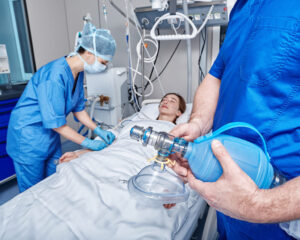A new study will take a closer look at the viability of flu and coronavirus after aerosol-producing events in hospitals.
As the COVID pandemic began to unfold in late 2019, researchers around the world scrambled to learn as much as possible about the novel virus responsible. Until more was known about how this microorganism was making the jump from person to person, the only surefire mitigation strategy involved strict lockdowns and quarantines. And even as more of the picture came into focus, healthcare experts, policymakers, and the general public clashed over the remaining uncertainty.
While a better understanding of the coronavirus has enabled most of public life to return to pre-lockdown routines, one critical setting still struggles with this uncertainty: hospitals. Working with or around infected patients means that coming into contact with virus-laden aerosols is unavoidable, but the riskiness of any given interaction is difficult to assess.

Now, researchers at the University of Utah are conducting a study that aims to quantify these risks in a more fundamental way than ever before. Rather than relying on intuition or guesswork, hospitals will have real data on how infectious viruses remain after common aerosol-generating procedures, from performing CPR to changing a patient’s bedsheets.
The study is being led by Kerry Kelly, associate professor of chemical engineering in the University of Utah’s John and Marcia Price College of Engineering. She is collaborating with researchers at the U’s Spencer Fox Eccles School of Medicine, including Darrah Sleeth, associate professor in the Division of Occupational & Environmental Health and at the Rocky Mountain Center for Occupational and Environmental Health, Catherine Loc-Carrillo, adjunct assistant professor in the Division of Epidemiology, and Kristi Warren, research assistant professor in the Division of Pulmonary Medicine, as well as Rachael Jones at the UCLA Fielding School of Public Health.
When working with patients known to have a contagious disease, healthcare providers and other hospital workers follow a litany of procedures to protect themselves, as well as other patients, from infection. These procedures are tailored to the organism in question and the risk entailed by the specific interactions the patient requires.
Coronavirus still presents a particular challenge for infection control given how quickly and easily it spreads. With viruses hitching a ride on the moisture of every exhale, even the most basic interactions with infected patients could be considered high risk.
Previous attempts to quantify this exposure risk have measured how much viral genetic material aerosols contain, but this data is limited when it comes to a key element: just because viral DNA or RNA is present in the sample does not mean that it was part of a functioning virus when it was captured.
“When you pull air through a solid filter, you can catch virus-carrying aerosols, but then they quickly dry out and die,” Kelly says. “By capturing them in a liquid, we’ll be able to tell whether the aerosols emitted by these procedures contained enough viable virus to actually cause an infection.”
Kerry has been working with this technology as part of her research on particulate-based air pollution. When the pandemic hit and the risk of various activities became a fiercely debated topic, she immediately began brainstorming how to apply her expertise to the problem.
“There are many activities that take place in a hospital that could be considered ‘aerosol-generating procedures,’” says Sleeth. “Although it seems obvious that some are riskier than others, there still isn’t a good way of comparing them. That means decisions are currently being made with incomplete information, and that can have real consequences for both patients and healthcare workers.
Supported by a 3-year $2.3 million grant from the National Institutes of Health, the Utah and UCLA researchers will collect aerosol samples from real hospital interactions with both influenza and COVID patients. The potential aerosol-generating procedures studied will include medical procedures with obvious risks of encountering aerosols, such as intubating a patient or measuring their pulmonary strength, as well as everyday interactions, such as changing bed linens.
Once captured, the researchers will be able to associate particle sizes with viral load and virus viability, with a long-term goal of developing appropriate protective measures. Correlating an aerosol’s diameter to its likelihood of containing functional viruses, for example, could directly inform infection control procedures, such as what kinds of personal protective equipment are necessary for a procedure.
“The best ways to protect healthcare personnel from infectious aerosols remains quite controversial among some stakeholders, but it is critical to the health of workers and patients that we build an evidence base that enables robust decision making,” says Jones.